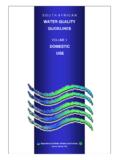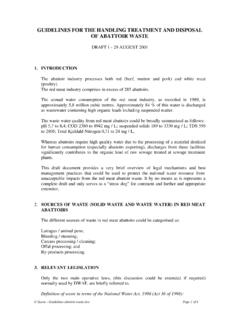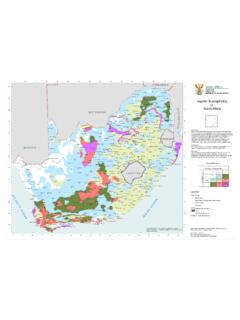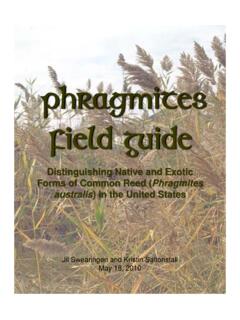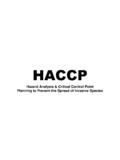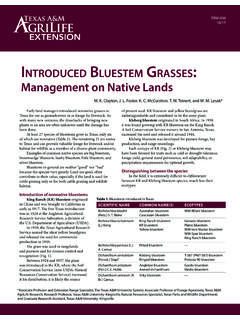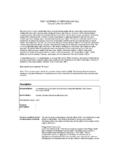Transcription of Costs and benefits of biological control of invasive alien ...
1 Costs and benefits of biological control of invasivealien plants : case studies from South van Wilgen, de Wit, Anderson, Le Maitre, Kotze,S. Ndala, B. Brownand RapholoIntroductionInvasive alien species are a significant and growing threat to allof the world s ecosystems. They can spread at alarming rates,displace native vegetation, disrupt important ecosystem processes,and have serious environmental ,2 Land managers arebecoming increasingly concerned about the phenomenon,and are seeking cost-effective ways of combating the spreadof invasive species. One of the remarkable characteristics ofinvasive alien plants is that few, if any, of them are invasive intheir countries of origin their ability to grow vigorously andproduce copious amounts of seeds is kept in check by a host ofco-evolved invertebrates and pathogens.
2 Some of these plantspecies, when transported to a new continent without the atten-dant enemies, exhibit ecological release . This phenomenonallows the introduced species to multiply rapidly in the absenceof a host of attendant invertebrates and diseases, with associatedtendencies to spread rapidly and to out-compete native control (or biocontrol) involves the deliberate intro-duction of invertebrates or diseases, and is aimed at reducing theeffects of ecological release, and arriving at a situation where theplant is returned to the status of a non- invasive naturalized alien (an alien plant that is able to survive, and even reproduce, butdoes not invade aggressively in its new habitat). Biocontrol ispotentially very cost-effective, and environmentally concerns to the contrary,3the modern practice of usingcarefully screened and host-specific biocontrol agents is safe,and host shifts (where non-target plants are attacked by theintroduced agent) have not occurred in the over 350 recordedcases where weed biocontrol agents have been used South Africa, biocontrol has been practised since 1910, and,to date, 103 biocontrol agents (including invertebrates andpathogens) have been released against 47 weed species,5makingSouth Africa the third most active country in biological controlafter the and Australia.
3 South Africa s biocontrol scientistsform a relatively small, united and committed community. Theyhave conducted collaborative research over the past 30 years,and have an impressive track record,5,6with many weeds havingbeen effectively brought under benefit studies of biocontrol programmes generallyindicate positive returns on investment. McConnachieet nine studies that had taken place between 1939 and2000, all of which indicated positive benefit:cost ratios rangingfrom :1 to 53:1, with a mean of 18:1. In Australia, a benefit:costratio of 14:1 in 2015 (rising to 47:1 in 2050) was estimated forresearch into, and release of, biocontrol agents on Patterson scurse (Echiumspecies).8 Patterson s curse causes severe losses inthe productive potential of grazing lands. Another Australianstudy9estimated the benefit:cost ratio for biocontrol of bitoubush (Chrysanthemoides monilifera) to be :1, arising fromsavings in control Costs , and increased amenity and , we would expect similar positive returns in the caseof such programmes in South Africa.
4 However, limited resourceshave meant that scientists have concentrated their efforts on theidentification, screening, release and establishment of agents,and once established, further monitoring of the effects on a largescale were not carried out. Cost benefit studies therefore tend tobe rare exceptions rather than the this paper, we attempt to estimate the Costs and benefits ofthe biocontrol of six weed species in South Africa. The studyWorking for WaterSouth African Journal of Science100, January/February 2004113aCSIR Division of Water, Environment and Forestry Technology, Box 320,Stellenbosch 7599, South Division of Water, Environment and Forestry Technology, Box 395, Pretoria0001, South Africa.*Author for correspondence. E-mail: alien species can have significant negative environmentaland economic impacts.
5 Such species are often controlled biologi-cally by means of introducing host-specific insects or pathogensthat can reduce the species invasive potential. In many cases, plants are brought under complete control . In this paper, we describean attempt to estimate the Costs and benefits of the biocontrol of sixweed species in South Africa. We estimated the Costs of biologicalcontrol research that was conducted on the plants , the rate at whicheach of these species spreads in the absence of biological control ,and the degree to which spread has been arrested or reversed bybiological control . This, in turn, was used to estimate the extent towhich the species would have spread had biological control notbeen introduced. We then estimated the most likely levels ofconsequences associated with uncontrolled spread.
6 The effectswere expressed in the form of three categories of benefitsassociated with the prevention of invasion: the loss of water due toexcessive transpiration by invasive plants ; reductions in the valuesof land that became invaded; and reductions in value added bybiodiversity to ecosystem services. We compared these benefitswith the Costs of biological control research in order to derivecost:benefit ratios. The economic benefits of preventing invasionranged from R300 ha 1yr 1for jointed cactus (Opuntia aurantiaca)toR3600 ha 1yr 1for golden wattle (Acacia longifolia) (values arediscounted to the year 2000). The economic value of wateraccounted for 70% of the combined benefits . Benefit:cost ratios forthe historical analysis (from the release of the biocontrol agent tothe year 2000) ranged from 8:1 for lantana (Lantana camara)to709:1 for jointed cactus.
7 When future estimates of benefits wereconsidered, benefit:cost ratios were greater, and ranged from 34:1for lantana to 4333:1 for golden wattle. These large differences canbe attributed to the length of time that the biocontrol agents havebeen released (this ranged from 13 to 65 years for different weedspecies) as well as to the 30-fold differences in the potential areathat different weed species would eventually invade. A sensitivityanalysis revealed that the model was sensitive to changes in theestimated rate of spread. The sensitivity analysis also showed thatthe returns on investment in biological control research generallyremain positive with some variations between identified as a priority by research managers, based onthe threats facing the biocontrol research community and thebenefits that they deliver, and the lack of any attempt to quantifythese benefits to major funding agencies and approachWe set out to estimate the benefits of biological control at anational scale in South Africa.
8 This is a key aspect that needs to beassessed in order to make informed policy decisions, but it is onethat requires an interdisciplinary approach at a scale that isseldom attempted. Our study required us to make estimatesof the impacts of biological control at a national scale, in theabsence of detailed data on the extent of invasions, on the effectsof biological control agents on populations rather than individ-ual plants , and on the economic consequences of invasion. It wasthus necessary to make various assumptions in the absence of data,and we consulted leading experts and practitioners in the fieldwhen formulating many of these assumptions. Where assump-tions were made, these are explicitly shown. Our approachinvolved estimating the Costs of biological control research thatwas conducted on six invasive alien weed species in SouthAfrica.
9 We attempted to estimate the rate at which each of thesespecies spreads in the absence of biological control , and the degreeto which spread has been arrested or reversed by biologicalcontrol for each of these species. This, in turn, was used to esti-mate the extent to which the species would have spread hadbiological control not been introduced. Finally, we attempted toestimate the most likely levels of impact associated with uncon-trolled spread, and compared this to the Costs of biologicalcontrol research in order to derive cost:benefit of speciesWe selected six species (Table 1) as examples of invasive alienweeds that had been subjected to biological control in SouthAfrica. The species were chosen to illustrate a range of outcomeswith respect to the degree of control achieved (Table 2).
10 Theyincluded those that had become major problems before the startof biological control , as well as species that were known to haveinvasive potential (such asAcacia pycnantha), but that had notyet spread to any significant extent. In some cases, a number ofbiological control agents for the six selected species werereleased but failed to establish Table 1 shows only the agentsthat have established, together with the degree of damage eachagent currently inflicts on the target weed. The combined effectof the agents on populations of all weed species exceptLantanaiseither substantial or complete (Table 2).Estimating the rate of spread of invasive speciesThe spread of an invading organism generally follows asigmoid curve over 12 The initial expansion is slow as thefounder colony becomes established, and increases rapidly asthe colony expands and starts new colonies, decreasing again asthe potential habitat (invadable area) becomes fully logistic model represents this process, and we used it in adiscrete form with annual time steps as follows:Nt=Nt 1+r(1 Nt 15/K)Nt 1(1)whereNis the number of spatial units occupied;tis the currenttime step,t 1 is the previous time step;ris the intrinsic rate ofincrease, andKis the potentially invadable area.
